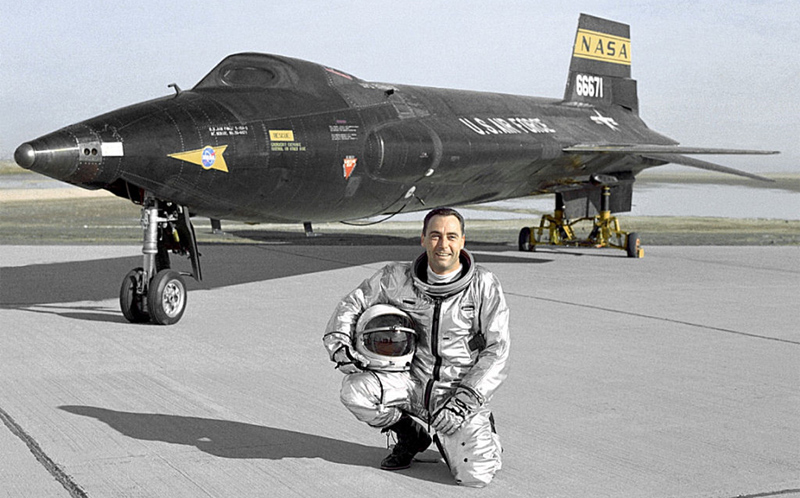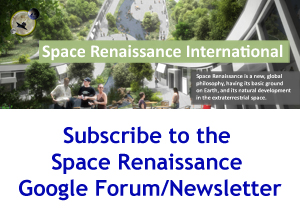
There is no doubt that the space frontier will be opened by private enterprise and our focus remains on the private sector. But it hasn’t happened so far. The long promised start of commercial suborbital flights did not occur as expected. However, in the meantime, SpaceX has become a key part of the revolution by developing reusable rockets obtaining NASA contracts. Reducing the cost to orbit objectively supports the civilian astronautics development which allows more private enterprises to enter the market. Robert Bigelow is also taking key steps in the area of civilian astronautics with the first experimental inflatable module deployed on the ISS and by working with NASA as well.Jeff Greason, who recently joined the Space Renaissance USA Chapter, says that there is more work to be done between LEO and GEO than what we expect. So attention students, both young and less young specialists, please take good note that: “one thread that people don’t seem to emphasize” said Jeff “is that the number one problem in the space economy right now is … a shortage of labor! There are many, many activities which cannot be conducted economically because there is an insufficient source of labor in the space industry to do the jobs that need doing.”
Q. So, Jeff, let’s start with this quite interesting point. Could you tell us something more about the activities you are talking about?
R. Today, the bulk of activity in space is satellites. Most of the expense of satellites isn’t directly in the launch cost – though indirectly, the constraints of launch being expensive and hard to schedule are a big driver. But satellites have a lot of mechanisms to unfold solar arrays and antennas, and the components which might be quite affordable for a terrestrial application are expensive because they have to withstand a very rough ride on launch, and then last for ten years or more without maintenance or repair. Now imagine there was a facility for doing some very simple assembly work on orbit, and transportation from LEO to GEO. Satellites are very modular – so many transponders, so big an antenna array, so much solar panel. You could send those elements up, plug the modules together, and build quite large satellites ‘by the meter’ so to speak. It would be a simple task for a technician – if only you had technicians. A lot of money has been spent on research to service and repair GEO comsats. If instead you brought them to a technician, again, most of that could be done. And we know there are materials on the Moon of tremendous economic interest – water for propellant for one example. What’s missing isn’t the machines to do the mining and processing; they’re relatively simple and could be launched if there were need. But they need to be set up, maintained, and repaired – a small base could provide that labor, if economic activity were its focus rather than scientific research. Energy harvesting in space is a definite possibility, but again, the requirement to make the entire architecture 100.00% self-assembling is a big driver of cost; it doesn’t take much to plug pieces together.
Q. On the bad side of the news, we observe that Virgin Galactic was forced to build a new SpaceShipTwo after the tragic accident in 2014 and is still on ground, and that XCOR seems to have suspended the Lynx program, in favor of projects that are bringing in revenue.
Is that only due to difficulties in fundraising and finding investors or are we also witnessing a strong resistance by military lobbies and governments to release their control on outer space enabling private commercial ventures? If so, how could SRI’s lobbying action in favor of paradigm changing measures be effective?
R. There’s been absolutely no resistance from military lobbies that I have seen – if anything, there is friendly interest in the developments of frequent, reliable, affordable space transportation. The space environment is changing – it is no longer a place where military assets are safe from interference by hostile powers. So the best way to peacefully maintain space as a place for the use of all nations is to make satellites not worthy targets to attack. Making them easy and cheap to replace is an excellent way to do that. So there is a lot of beneficial overlap between commercial and military interests in space.
All space endeavors have, until recently, been very difficult to finance. What’s changed that is that small satellites have shortened the development cycle for commercial satellites so that new applications can be tried and show their economic value – or fail – within a few years, which is the time horizon of interest to institutional investors. The reason I’m working on the business plan at Agile Aero is to try and do the same thing for space vehicles – shorten their development cycle. But until we, or someone, does that, investment in space transportation is going to remain a challenge. That’s why right now the bulk of the investment in that area is from high net worth individuals investing in their own projects – which is a very welcome development, but not enough of a foundation for a healthy industry.
Q. Today, Space Renaissance International is making a qualitative and quantitative step, as we say, towards SRI 2.0. Since the end of 2008, our first years of activities, SRI was mainly a philosophical association, a think tank dedicated to developing the advanced concepts of a space age philosophy and to indicate the main strategic direction for our civilization. Recently , SRI more than doubled its presence on social networks, with almost twenty national Facebook pages world wide. SRI USA was incorporated as a 501(c)4 non profit association by Manuel Perez, with a quite focused strategic plan which includes lobbying the US Congress and collaboration with government agencies. Thus, SRI will now develop political goals and not only philosophical ones, by working with national and international institutions and striving to unify as much as possible the space advocacy movement on a platform of a few shared goals. Each national chapter will be encouraged to develop its own proper plan tuned to the national environment and social climate where they are located.
In such perspective, some questions become relevant for SRI as well as for the broader space advocacy movement from a strategic point of view.
Elon Musk has invested much of his previously accumulated fortune – made by brilliant great inventions, such e.g. PayPal — in his SpaceX enterprise and few other futuristic industrial ventures, e.g. the Tesla electric car and the very high speed vacuum tube train. It appears however evident that, with regards to Richard Branson and other new space entrepreneurs, Musk has something extra that allows him to produce many rockets and to recover from accidents in just a few months. The availability of substantial capital is due to the contracts that NASA is assigning to SpaceX for the use of Falcon 9 rockets and Dragon capsules to serve the ISS. It is likely that this momentum is also attracting further investments to SpaceX which now appears to be a successful corporation.
NASA already named the first four astronauts who will fly on the first U.S. commercial spaceflights in private crew transportation vehicles being built by Boeing and SpaceX, as soon as mid-2017, if all goes well. (Gizmodo).
NASA, by supporting SpaceX with lucrative contracts, is de facto supporting the development of fully reusable launch vehicles which is something that space advocates have been promoting for at least thirty years as the essential key factor for the downsizing of the cost of transportation from Earth to orbit. Consequently, the development of a private commercial space industry and market is being supported as well.
But this is not the only good news. On the other side of Atlantic, ESA’s new director Johann-Dietrich Woerner from the German DLR was selected in 2015. During his first interview, he challenged ESA with a grand goal: to build a first village on the Moon during the 2020-2030 decade! Such strategic address was initially announced in a symposium – Moon 2020-2030 – that was held at ESTEC, in Noordwijk in December 2015. If realized, this would be a key step on a path of settlement of outer space.
How do you see this process? Is NASA supporting the development of civilian astronautics by giving contracts to Elon Musk? Is that within the frame of a strategic plan? Or is it just the basis of a pragmatic orientation, because lower launch costs is however convenient?
R. Talking about “NASA” and “strategic plan” together probably overstates the case. NASA is a collection of dissimilar interests flying in formation. I would love to see an overall strategic plan for NASA but so far I haven’t. Certainly, however, national policymakers and some farsighted people within NASA have seen the value of adding NASA’s demand to commercial and military demand to stimulate the overall launch market – and of course so the taxpayer can derive the benefits of lower prices that come from a more competitive launch industry. It’s been a slow process dating back to the decision in 1986 to withdraw the Space Shuttle from the commercial launch market. Not everyone realizes that all the military launches in the U.S. and all NASA science missions are already launched on commercial rockets and have been for some time. NASA is providing the critical early customer support for SpaceX and ATK rockets by purchasing commercial cargo service to the Space Station and is doing the same for crew transport on Boeing and SpaceX capsules. I think that is all positive. There are some enormous missed opportunities, however. NASA is still spending about $2 billion a year on a large heavy lift booster that will start with 75 ton and eventually lift 125 ton payloads to orbit and fly every other year. That same price would pay to put up over 300 tons per year on the existing commercial market – and if an additional 300 tons per year of launch were purchased, the price would certainly come down. It’s really a mistake to think of this in terms of one provider; thanks to the efforts of both military and NASA launch the U.S. is now the only country with internal competition for launch and that competition is really improving the performance of ALL of the providers.
Q. Whatever the rationales behind this new orientation of the major space agencies, there seems that a new phase is opening in which many new space enterprises, having civilian astronautics in their mission, can hope to get contracts and to work with space agencies in order to develop technologies that will favor the growth of the commercial astronautic industry. There is, not yet, a big private space travelers market, but it is however a serious development vs. the old exploration paradigm. So, in your opinion, which are the themes upon which a new space enterprise may consider working with NASA, while being coherent with its own civilian astronautic mission?
R. I think the real opportunities are ahead of us. For decades, ambitious human spaceflight goals have been discussed by NASA and other space agencies. Expeditions to Mars, bases on the Moon, visits to near-earth asteroids. The private sector is talking seriously about private robotic missions to the Moon, or human missions to Mars orbit, and providing resources from the Moon and near-earth asteroids. The opportunity for NASA and other space agencies is that if they planned such ambitious missions, NOT as the agency that would perform the mission but simply as customers for those missions, leaving most of the execution to private sector firms to do in the most cost-effective manner, then they could actually afford to DO the things we’ve dreamt of. For example I’ve little doubt that a human return to the Moon, even with a permanent base could be done privately for something on the order or $10-$20 billion. No space agency is likely to do that so cheaply, and it is very difficult for the private sector to justify spending that money. But if space agencies really wanted a return to the moon – they can afford it, if they just buy it. And of course the space agencies have relevant expertise – but that expertise can be made available to private actors where there is need. All these efforts feed each other – the more things are being done in space, the easier it is to do more. For example, if there were some kind of transportation node in cislunar space – say at L1 or L2, it would be easy to stage components for a Mars mission from there, eliminating the need for very heavy lift launch beyond what other customers demand. But sadly, there are still too many in national space efforts who view ambitious space goals not as ends to be achieved, but as justifications for ongoing programs that will be funded year after year, with little incentive to reach the goal and move to the next one.
Q. We have always in mind your historical slides presented at the ISDC 2011, when you were talking about the missing 2nd step of the NASA strategic vision: “step 1 = exploration / step 2 = ? / step 3 = settlement”. We at SRI represent step 2 as a coherent plan for a progressive industrial expansion beyond Earth’s atmosphere based on humanist concepts, starting from LEO, recovering and reusing space debris, developing interorbital maneuverability, improving re-entry technologies, then developing infrastructure in the cislunar space, L4 and L5, on the Moon, using Near Earth Asteroids as raw materials and possible habitats.
What is your vision of a coherent plan for colonization of the Geo-Lunar space region?
R. The missing element right now is extraterrestrial sources of propellant. We know they’re out there, we know how to get them, but we haven’t developed those resources. Once we have that, moving from LEO to GEO, or from LEO to destinations beyond LEO, becomes much more cost effective. I personally think we will need humans to maintain and operate some of that equipment, which implies a transportation capability for people as well as cargo and a logistics resupply ability to bring cargo where we need it to be. Whether that material comes from Lunar or asteroidal sources or (as I suspect) from both doesn’t really matter – once we start to disconnect our umbilical to Earth and supply a big part of what we need to do things in space from resources IN space, we’ll be well on our way to a virtuous cycle where more and more of that becomes the norm. Once you start extracting resources, your next need is energy – it takes a lot of energy to extract and process that material. And of course there’s no shortage of demand for energy on Earth either; we’re 10-15 Terawatts short of what it would take to bring the whole world up to a modern standard of living. So the same infrastructure we need to collect industrial quantities of energy from the Sun, in space, for space-based customers can over time extend to supplying our needs here on Earth.
Q. From our humanist point of view, the overdue change of paradigm – from space exploration to space settlement – a few key areas of scientific research should have an high priority. If it is foreseen that the number of civilian passengers and settlers will increase in space, especially beyond the protective Van Allen Belt, the issues of protection from cosmic radiations and artificial gravity should be addressed, in order the migrants will not be subject to fundamental physiological changes in a few years. These type of research should be better developed by public money, as well as scientific research for a single stage to orbit vehicle, and exobiology, selecting the best vegetables to be cultivated in space, for food and for oxygen regeneration. Do you think a lobbying action may have a chance to orient governments and agencies in such a direction?
R. I hope so, but I’m not counting on it. The idea that the goal of government action in space shouldn’t be to visit it, but to develop it as an economic arena and frontier for human settlement is one that has been growing slowly and not always steadily. Clearly, that is not yet motivating our investments in space research because these problems remain unsolved. It is unpardonable neglect of our research priorities that more than 50 years in to the space age, we still have NO idea what the long term health implications of 1/6 or 1/3 gravity are on human beings. If national space agencies have a purpose, this is the kind of problem they should be solving. And again, how they solve it matters. If they think it’s too expensive – then put out a contract to buy that data. A lot of smart people have been thinking of cheap ways to get that data – surely there is SOME price at which NASA or ESA could afford to answer this question.
[English language editing by Arthur Woods]
OTHER LANGUAGES VERSIONS OF THIS ARTICLE:
Join the Space Renaissance!
2016 is seeing an incredible growth of the SRI presence on the social media, Facebook mainly.
Do you believe in the space renaissance? Then Join the Space Renaissance!
If your country does not have a national SRI chapter already, you can register as a member of Space Renaissance International, here:
https://spacerenaissance.space/build-sri-with-us/membership-2/membership/.
If you like to keep on receiving our analysis, newsletters and updates about our initiatives, please subscribe to the SRI newsletter here:
https://spacerenaissance.space/build-sri-with-us/space-renaissance-newsletter-registration/.
If you have already subscribed once, there is no need to subscribe again.








 Space Renaissance France Chapter
Space Renaissance France Chapter  Space Renaissance USA, Inc.
Space Renaissance USA, Inc.  Space Renaissance Italia Chapter
Space Renaissance Italia Chapter Space Renaissance Academy
Space Renaissance Academy Space Renaissance Initiative Group
Space Renaissance Initiative Group